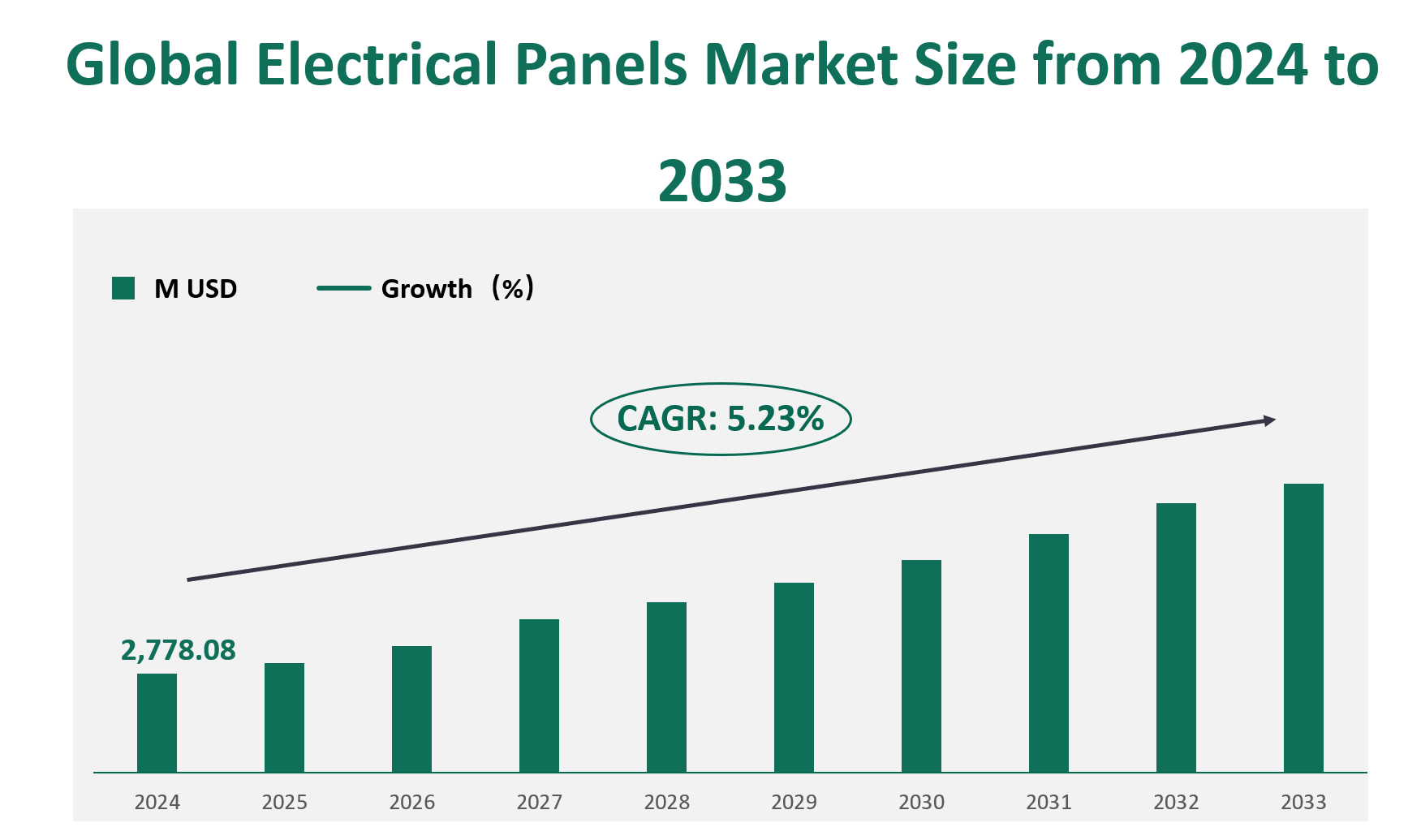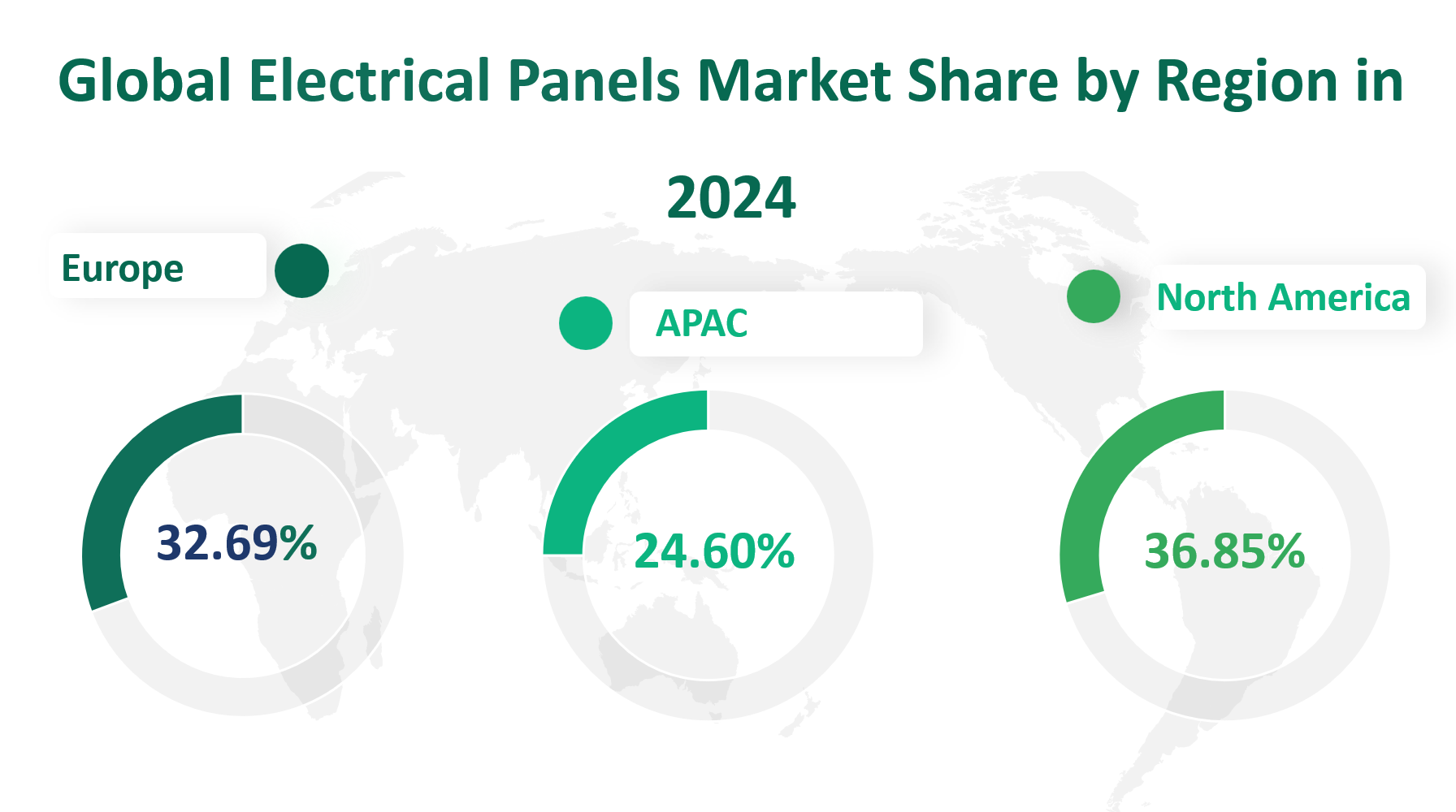1. Global Electrical Panels Market Insight Analysis
In 2024, the global Electrical Panels market revenue is estimated to reach 2,778.08 million USD, with a Compound Annual Growth Rate (CAGR) of 5.23% from 2024 to 2033.
An electrical panel is a critical component of an electrical distribution system, designed to divide electrical power into branch circuits while providing protection devices for each circuit within a common enclosure. It serves as the central hub for power distribution in residential, commercial, and industrial settings. Electrical panels are essential for preventing power overloads and short circuits, ensuring the safe and efficient distribution of electricity throughout a building or facility. As urbanization accelerates and the demand for electricity grows, the role of electrical panels becomes even more vital in modern infrastructure.
Figure Global Electrical Panels Market Size (M USD) and CAGR (2024-2033)

2. Driving and Limiting Factors of Electrical Panels Market Growth
The growth of the Electrical Panels market is driven by several key factors. Firstly, the increasing urban population, particularly in regions like Asia and Africa, is driving the demand for robust electrical infrastructure. By 2050, it is projected that two-thirds of the global population will live in urban areas, leading to a surge in the need for reliable power distribution systems.
Secondly, the rising number of electronic devices in households and commercial spaces is increasing the electrical load, necessitating advanced and safer electrical panels. Additionally, governments worldwide are implementing stricter regulations for electrical safety, further boosting the market demand.
However, the market also faces certain challenges. The cost of raw materials, such as copper and steel, can significantly impact production costs. Fluctuations in commodity prices may erode profit margins, especially for manufacturers who cannot pass on increased costs to their customers.
Another limiting factor is the slow pace of distribution network construction and transformation in some regions. Delays in upgrading existing infrastructure can hinder the adoption of new electrical panels. Lastly, the market faces intense competition due to product homogenization, making it difficult for new entrants to gain a foothold without significant investment in innovation and branding.
3. Technology Innovation and Corporate Mergers and Acquisitions in Electrical Panels Market
Technological innovation plays a crucial role in the advancement of the Electrical Panels market. Manufacturers are continuously investing in research and development to improve the efficiency, safety, and functionality of their products. For instance, smart electrical panels equipped with IoT (Internet of Things) technology are gaining popularity. These panels can monitor and manage power consumption in real-time, providing valuable insights and enhancing energy efficiency. Additionally, advancements in material science are leading to the development of more durable and corrosion-resistant panels, further extending their lifespan and reliability.
Corporate mergers and acquisitions are also shaping the market landscape. Major players such as Eaton, ABB, and Schneider Electric are leveraging strategic partnerships and acquisitions to expand their product portfolios and strengthen their market positions. These consolidations allow companies to integrate complementary technologies, enhance their R&D capabilities, and achieve economies of scale. For example, Eaton’s acquisition of certain electrical panel manufacturers has enabled it to offer a broader range of products and solutions, catering to diverse customer needs.
4. Global Electrical Panels Market Size by Type
Electrical panels are integral components in electrical distribution systems, designed to manage and protect electrical circuits from overloads and short circuits. The two primary types of electrical panels are Main Breaker and Main Lugs.
Main Breaker panels are designed for service entrance applications. They feature a main breaker that connects the incoming supply cables to the panel, providing overcurrent protection and the ability to disconnect power. This type of panel is essential for residential and commercial buildings, ensuring safe and efficient power distribution. In 2024, Main Breaker panels are projected to generate significant revenue, driven by their versatility and reliability.
Main Breaker panels are expected to achieve a revenue of approximately USD 1,852.85 million in 2024. This substantial revenue is attributed to their widespread use in both new constructions and retrofit projects, particularly in regions with growing infrastructure demands.
Main Lugs panels, on the other hand, do not have a main circuit breaker. Instead, they rely on main lugs and bus bars to connect directly to the incoming supply cables. These panels are primarily used as distribution panels in systems where a main breaker is already upstream. They are often employed in commercial and industrial settings, where flexibility and expandability are crucial.
The revenue for Main Lugs panels is forecasted to reach USD 925.23 million in 2024. While this figure is lower than that of Main Breaker panels, Main Lugs panels still hold a significant market share, especially in applications requiring secondary or downstream distribution.
Table Global Electrical Panels Market Size by Type in 2024
5. Global Electrical Panels Market Size by Application
Electrical panels find extensive use across multiple applications, each with unique requirements and market dynamics. The primary applications include Residential, Commercial, and Other (industrial and miscellaneous uses).
Residential applications of electrical panels encompass single-family homes, apartments, and multi-family dwellings. These panels ensure safe and efficient power distribution within households, protecting against electrical overloads and short circuits. The growing demand for modern, energy-efficient homes drives the need for advanced electrical panels.
The residential application segment is projected to generate a revenue of USD 1,826.91 million in 2024. This significant revenue reflects the continuous demand for reliable power distribution solutions in the expanding residential sector.
Commercial applications cover offices, retail spaces, hotels, and other non-residential buildings. Electrical panels in these settings must handle higher power loads and more complex distribution requirements. The increasing number of commercial constructions and the need for efficient energy management contribute to the growth of this segment.
The commercial application segment is expected to achieve a revenue of USD 866.30 million in 2024. This revenue is driven by the growing commercial real estate market and the demand for advanced electrical infrastructure.
Table Global Electrical Panels Market Size by Application in 2024
Application | Market Size (M USD) 2024 | Market Share |
Residential | 1826.91 | 65.76% |
Commercial | 866.30 | 31.18% |
Other | 85.80 | 3.09% |
6. Global Electrical Panels Market by Top Regions
North America remains a significant market for Electrical Panels, driven by robust economic conditions and continuous infrastructure upgrades. In 2024, the region is projected to generate a revenue of USD 1,023.61 million.
Europe is another major market, with a forecasted revenue of USD 908.18 million in 2024. The region’s market is influenced by stringent safety regulations and the need for energy-efficient solutions.
The Asia-Pacific region is emerging as the fastest-growing market for Electrical Panels. With a projected revenue of USD 683.47 million in 2024, this region is driven by rapid urbanization and industrialization in countries like China and India.
Latin America is also experiencing steady growth in the Electrical Panels market, with a forecasted revenue of USD 75.87 million in 2024.
Middle East and Africa: The Middle East and Africa region is projected to generate a revenue of USD 86.96 million in 2024.
Figure Global Electrical Panels Market by Region in 2024

7. Global Electrical Panels Market Analysis by Major Players
7.1 Eaton
Company Introduction and Business Overview: Eaton is a global leader in power management solutions, offering a wide range of electrical and industrial components. Founded in 1916 and headquartered in the United States, Eaton is renowned for its innovative and reliable products.
Products Offered: Eaton provides a comprehensive range of Electrical Panels, including Main Breaker and Main Lugs panels. Their products are designed for residential, commercial, and industrial applications, ensuring safe and efficient power distribution.
7.2 ABB
Company Introduction and Business Overview: ABB is a Swiss multinational corporation specializing in power and automation technologies. Established in 1988, ABB operates globally, offering a diverse range of products and solutions for various industries.
Products Offered: ABB’s Electrical Panels are known for their advanced features and reliability. They offer both Main Breaker and Main Lugs panels, catering to different market needs. Their products are widely used in commercial and industrial settings.
7.3 Schneider Electric
Company Introduction and Business Overview: Schneider Electric, founded in 1836 and headquartered in France, is a global specialist in energy management and automation. The company offers a wide range of products and solutions for residential, commercial, and industrial applications.
Products Offered: Schneider Electric provides a variety of Electrical Panels, including Main Breaker and Main Lugs panels. Their products are designed to ensure efficient power distribution and protection, with a focus on energy efficiency and sustainability.
7.4 Siemens
Company Introduction and Business Overview: Siemens, founded in 1847 and headquartered in Germany, is a global technology powerhouse specializing in industry, infrastructure, mobility, and healthcare. The company is known for its innovative and reliable products.
Products Offered: Siemens offers a comprehensive range of Electrical Panels, including Main Breaker and Main Lugs panels. Their products are designed for various applications, ensuring safe and efficient power distribution.

